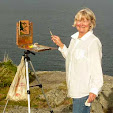There's a problem with this painting (OK maybe two problems). The first problem came to my notice when I sent a photo off to friend. She thought that there was a meadow in front of the trees on the right. Hmmm, it's supposed to be clumps of small plants floating on the water. Smaller than lily pads, bigger than algae. I asked myself why it doesn't look right. And to aid in the analysis, I went back to the scene, got out my trusty grid on plexiglass, and did a quick outline on top of the grid of what I was seeing.
Despite the fact that the reflection is different (it wasn't as windy this morning as when I painted the piece), it's pretty easy to see the problem now. The floating plants on both sides take up too much space vertically. They need to flatten out. I decided that those on the left weren't too bad (even if they don't look like the drawing on the plexiglass) and focused on the right side.
Above I wetted the dry painting with solvent and redrew the shape of the clump of plants in ultramarine blue.
And then I repainted the reflection on the right and added a few floating clumps in front to enforce the idea. I hope it looks more like floating plants to you now.
The plexiglass grid is an excellent tool to tell you when your drawing has gone wrong. And one of the most common ways drawings go wrong in landscape painting is when we are attempting to show a horizontal surface receding into the distance. Marsh paintings are particularly problematic. When this goes badly wrong, we appear to be hovering over the scene rather than looking into it.
You can make a plexiglass grid very easily. You'll need a piece of plexiglass from the hardware store. At my store they were happy to cut it for me. You'll also need a Sharpie permanent marker pen to make the lines and a ruler. You'll want a dry erase pen for drawing your scene, so that you can erase it. I made a bunch of these for my students in my recent drawing class and they've been put to good use.
To use the grid, you first need to check the aspect ratio. My plexiglass grids are 6"x8", so for this 8"x10" painting, I marked off a quarter of an inch on each side, making the grid 6"x7.5" (an 8x10 aspect ratio). Hold the grid in front of you until the view is enclosed by the grid. Holding steady, quickly sketch the shapes. Now move the grid back and forth in front of your painting until the painting fills the grid. Now you can see where your drawing has gone awry.
And actually, you don't need the grid if all you're trying to do is see whether your drawing has any issues. The plexiglass itself with the dry erase marker will do the trick. But the grid can be helpful in laying out your drawing, and in seeing whether your horizon is straight and whether the sides of buildings are vertical. And of course, it's better to do this at the drawing stage instead of painting over a problem.
The second problem is the slash of sky reflection in the water, it's a bit crooked. I think I fixed it well enough.






No comments:
Post a Comment